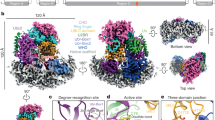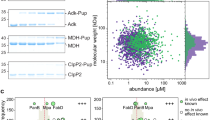Abstract
Ubr11 in the fission yeast Schizosaccharomyces pombe is an evolutionarily conserved ubiquitin ligase functioning in the Arg/N-end rule pathway, which promotes degradation of substrate proteins via the proteasome. Ubr11 recognizes the N-degron sequence in substrates. The primary N-degron contains a destabilization-inducing N-terminal amino acid, which is either a basic (type 1) or bulky hydrophobic (type 2) residue. Dipeptides are known to inhibit proteolytic degradation via the Arg/N-end rule pathway. Here, I examined the potency of some amino acid- or dipeptide-related molecules in their inhibition of Ubr11/N-end rule-mediated degradation. An amide form of l-arginine and l-tryptophan had weak inhibitory activity for type 1 and type 2 substrates, respectively, although the unmodified amino acid monomer and its carboxymethylated ester were ineffective. Among the naturally occurring dipeptides tested, Lys-Leu and Tyr-Leu showed potent inhibitory activity, but their effect was transient, especially at submillimolar concentrations. l-arginine-β-naphthylamide (Arg-βNA) showed stronger activity than several dipeptides for type 1 substrates, but all Lys-Leu, Tyr-Leu, and Arg-βNA caused growth retardation. The inhibitory activity of the l-phenylalanine carbobenzoxy-hydrazide for type 2 substrates was not very strong, but it prolonged the action of Tyr-Leu at low concentrations and, importantly, did not interfere with cell growth. Apart from their utility, these dipeptidomimetics provide a clue for understanding the determinants of recognition by Ubr ubiquitin ligase and further designing novel inhibitors of the Arg/N-end rule pathway.





Similar content being viewed by others
References
Bachmair A, Varshavsky A (1989) The degradation signal in a short-lived protein. Cell 56:1019–1032
Baker RT, Varshavsky A (1991) Inhibition of the N-end rule pathway in living cells. Proc Natl Acad Sci USA 88:1090–1094
Choi WS, Jeong B-C, Joo YJ, Lee M-R, Kim J, Eck MJ, Song HK (2010) Structural basis for the recognition of N-end rule substrates by the UBR box of ubiquitin ligases. Nat Struct Mol Biol 17:1175–1181
Dohmen RJ, Wu P, Varshavsky A (1994) Heat-inducible degron: a method for constructing temperature-sensitive mutants. Science 263:1273–1276
Forsburg SL, Rhind N (2006) Basic methods for fission yeast. Yeast 23:173–183
Fujiwara H, Tanaka N, Yamashita I, Kitamura K (2013) Essential role of Ubr11, not Ubr1 as an N-end rule ubiquitin ligase in Schizosaccharomyces pombe. Yeast 30:1–11
Gibbs DJ, Lee SC, Isa NM, Gramuglia S, Fukao T, Bassel GW, Correia CS, Corbineau F, Theodoulou FL, Bailey-Serres J, Holdsworth MJ (2011) Homeostatic response to hypoxia is regulated by the N-end rule pathway in plants. Nature 479:415–418
Gibbs DJ, Md Isa N, Movahedi M, Lozano-Juste J, Mendiondo GM, Berckhan S, Marín-de la Rosa N, Vicente Conde J, Sousa Correia C, Pearce SP, Bassel GW, Hamali B, Talloji P, Tomé DF, Coego A, Beynon J, Alabadí D, Bachmair A, León J, Gray JE, Theodoulou FL, Holdsworth MJ (2014) Nitric oxide sensing in plants is mediated by proteolytic control of group VII ERF transcription factors. Mol Cell 53:369–379
Gonda DK, Bachmair A, Wünning I, Tobias JW, Lane WS, Varshavsky A (1989) Universality and structure of the N-end rule. J Biol Chem 264:16700–16712
Hershko A, Ciechanover A (1998) The ubiquitin system. Ann Rev Biochem 67:425–479
Hu RG, Sheng J, Qi X, Xu Z, Takahashi TT, Varshavsky A (2005) The N-end rule pathway as a nitric oxide sensor controlling the levels of multiple regulators. Nature 437:981–986
Jiang Y, Choi W-H, Lee J-H, Han D-H, Kim J-H, Chung Y-S, Kim S-H, Lee M-J (2014) A neurostimulant para-chloroamphetamine inhibits the arginylation branch of the N-end rule pathway. Sci Rep 12:6344
Kearsey SE, Gregan J (2009) Using the DHFR heat-inducible degron for protein inactivation in Schizosaccharomyces pombe. Methods Mol Biol 521:483–492
Kim H-K, Kim R-R, Oh J-H, Cho H, Varshavsky A, Hwang C-S (2014) The N-terminal methionine of cellular proteins as a degradation signal. Cell 156:158–169
Kitamura K (2014) The ClpS-like N-domain is essential for the functioning of Ubr11, an N-recognin in Schizosaccharomyces pombe. SpringerPlus 3:257
Kitamura K, Fujiwara H (2013) The type-2 N-end rule peptide recognition activity of Ubr11 ubiquitin ligase is required for the expression of peptide transporters. FEBS Lett 587:214–219
Kitamura K, Taki M, Tanaka N, Yamashita I (2011) Fission yeast Ubr1 ubiquitin ligase influences the oxidative stress response via degradation of active Pap1 bZIP transcription factor in the nucleus. Mol Microbiol 80:739–755
Lee M-J, Pal K, Tasaki T, Roy S, Jiang Y, An JY, Banerjee R, Kwon Y-T (2008) Synthetic heterovalent inhibitors targeting recognition E3 components of the N-end rule pathway. Proc Natl Acad Sci USA 105:100–105
Matsuyama A, Shirai A, Yashiroda Y, Kamata A, Horinouchi S, Yoshida M (2004) pDUAL, a multipurpose, multicopy vector capable of chromosomal integration in fission yeast. Yeast 21:1289–1305
Matta-Camacho E, Kozlov G, Li FF, Gehring K (2010) Structural basis of substrate recognition and specificity in the N-end rule pathway. Nat Struct Mol Biol 17:1182–1187
Rao H, Uhlmann F, Nasmyth K, Varshavsky A (2001) Degradation of a cohesin subunit by the N-end rule pathway is essential for chromosome stability. Nature 410:955–959
Reiss Y, Kaim D, Hershko A (1988) Specificity of binding of NH2-terminal residue of proteins to ubiquitin-protein ligase. J Biol Chem 263:2693–2698
Sriram SM, Banerjee R, Kane RS, Kwon YT (2009) Multivalency-assisted control of intracellular signaling pathways: application for ubiquitin-dependent N-end rule pathway. Chem Biol 16:121–131
Sriram SM, Kim BY, Kwon YT (2011) The N-end rule pathway: emerging functions and molecular principles of substrate recognition. Nat Rev Mol Cell Biol 12:735–747
Sriram S, Lee J-H, Mai BK, Jiang Y, Kim Y, Yoo Y-D, Banerjee R, Lee S-H, Lee M-J (2013) Development and characterization of monomeric N-end rule inhibitors through in vitro model substrates. J Med Chem 56:2540–2546
Suzuki T, Varshavsky A (1999) Degradation signals in the lysine-asparagine sequence space. EMBO J 18:6017–6026
Tasaki T, Zakrzewska A, Dudgeon DD, Jiang Y, Lazo JS, Kwon YT (2009) The substrate recognition domains of the N-end rule pathway. J Biol Chem 284:1884–1895
Tasaki T, Sriram SM, Park KS, Kwon YT (2012) The N-end rule pathway. Ann Rev Biochem 81:261–289
Varshavsky A (2011) The N-end rule pathway and regulation by proteolysis. Protein Sci 20:1298–1345
Xia Z, Webster A, Du F, Piatkov K, Ghislain M, Varshavsky A (2008) Substrate-binding sites of UBR1, the ubiquitin ligase of the N-end rule pathway. J Biol Chem 283:24011–24028
Acknowledgments
This work was financially supported by management expenses grants to Hiroshima University from Ministry of Education, Culture, Sports, Science and Technology (MEXT), Japan. I thank Drs. Ichiro Yamashita and Nobukazu Tanaka for their help and discussions.
Author information
Authors and Affiliations
Corresponding author
Ethics declarations
Conflict of interest
The author declares that there are no conflicts of interest.
Additional information
Handling Editor: M. S. Palma.
Electronic supplementary material
Below is the link to the electronic supplementary material.
726_2015_2083_MOESM1_ESM.pdf
Supplementary material 1 Fig. S1 Reversibility of inhibition of Arg/N-end rule-mediated proteolysis by dipeptide. After the expression of ArgNd-GFP was induced, cells were cultured in the presence or absence of Lys-Leu at 1 mM for a further 3 h. The ArgNd-GFP levels were measured by flow cytometry at the indicated times. In the Lys-Leu-added cells, the ArgNd-GFP accumulated during this 3 h culture (top two histograms). Then, cells were washed and resuspended in the dipeptide-free medium at 0 h. Half of the culture was supplemented with thiamine to terminate the expression of ArgNd-GFP from the nmt1 promoter (yellow histograms). The other half of the culture was kept free of thiamine; thus transcription of the ArgNd-GFP mRNA continued (open histograms). The ArgNd-GFP levels were rapidly decreased in both cultures. Since ArgNd-GFP was expressed from the thiamine-repressible promoter (Pnmt1), addition of thiamine accelerated the decrease of the ArgNd-GFP in dipeptide-free conditions. Fig. S2 Necessity of the C-terminal extension for the inhibitory activity of Phe-NHNH-Z. Cells expressing TrpNd-GFP were treated with Phe-hydrazide or Phe-NHNH-Z for 6 h, and the TrpNd-GFP levels were measured by flow cytometry. The Phe-hydrazide, which lacks the carbobenzoxyl group, had lower inhibitory activity than Phe-NHNH-Z, indicating that the presence of the C-terminal extension may be necessary for the recognition of Phe-NHNH-Z by Ubr11 ubiquitin ligase. (PDF 121 kb)
726_2015_2083_MOESM2_ESM.pdf
Supplementary material 2 Fig. S3 DMSO affected the fluorescence intensity of GFP. (a) Cells expressing either TrpNd-GFP (left histograms) or ArgNd-GFP (top right histograms) were treated for 4 h with the various organic solvents indicated, and their fluorescence intensities were measured. DMSO specifically increased the GFP levels at relatively high concentrations in a dose-dependent manner. Two independent DMSO solutions from different companies (Sigma–Aldrich and Wako pure chemicals) were tested, and both had a similar effect (data not shown). At the final concentration of 0.5 % (v/v), which was used in this study, DMSO did not significantly affect the GFP fluorescent levels (bottom right histograms). (b) Cells expressing either ArgNd-GFP (lanes 1–4) or TrpNd-GFP (lanes 5–8) were treated with DMSO (lanes 2, 4, 6, and 7) or Tyr-Leu (lane 8) for 4 h. Cellular extracts were prepared and GFP levels were monitored by immunoblotting. The membrane was then reprobed with anti-Cdc2 antibody to examine the loading levels in each lane. (c) Addition of DMSO increased the GFP levels of MetNd-GFP and 6His−FLAGGFP. DMSO was added at 5 % (v/v). Note that both MetNd-GFP and 6His−FLAGGFP are stable proteins, which are not the substrates of the proteasome. Difference of the fluorescence intensity between two proteins reflected the strength of the promoters, which were used for expression (moderate strength of Pnmt41 for 6His-FLAGGFP and stronger Pnmt1 for MetNd-GFP). (PDF 439 kb)
Rights and permissions
About this article
Cite this article
Kitamura, K. Inhibition of the Arg/N-end rule pathway-mediated proteolysis by dipeptide-mimetic molecules. Amino Acids 48, 235–243 (2016). https://doi.org/10.1007/s00726-015-2083-1
Received:
Accepted:
Published:
Issue Date:
DOI: https://doi.org/10.1007/s00726-015-2083-1




